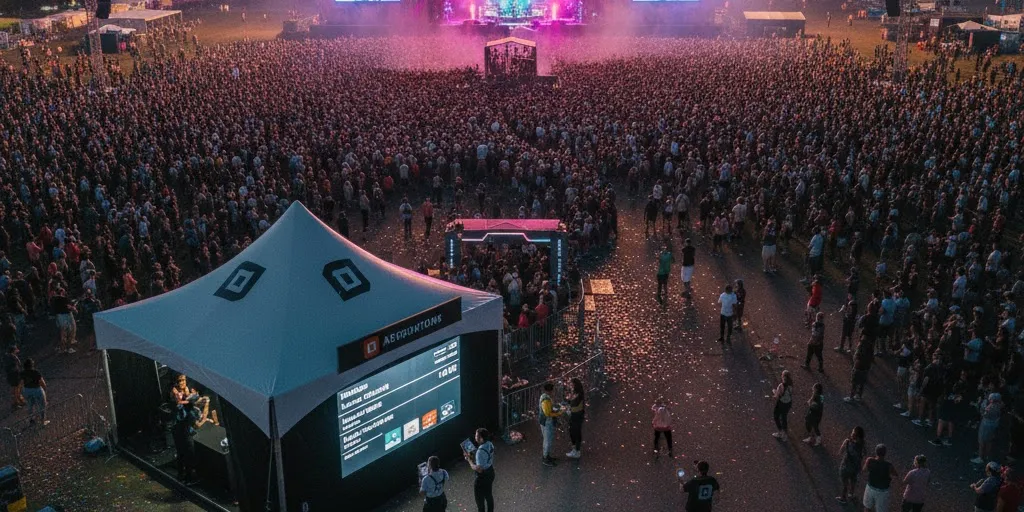A 10-minute delay in opening the gates at your 20,000-person festival can cost over $50,000 in lost initial bar revenue. This isn't a guess; it's a system failure rooted in poor large-scale event staffing. Most post-event reports track visible costs like overtime but ignore the massive hidden costs of these operational gaps. Poor staffing is not about "bad workers"; it's a failure in forecasting, deployment, and on-site management.
This guide is a technical, numbers-driven breakdown of the true costs, both visible and hidden, of staffing failures. We will provide falsifiable metrics, scenario math, and the specific process controls that prevent them, showing you how to transform expert large-scale event staffing into a powerful profit center.
CEO EXCERPT
Event chaos is expensive. We treat staffing as an engineering problem: model the risks and deploy a system of controls. This proactive, data-driven approach protects your revenue and brand.

Visible vs. Hidden Costs: The Full P&L Impact of Poor Staffing
Effective large-scale event staffing requires understanding the two types of costs associated with system failures. While one impacts your budget immediately, the other can damage your brand for years to come.
The Visible Costs (The Obvious Budget Hits)
These are the immediate, quantifiable expenses that show up on your post-event profit and loss statement.
- Overtime Pay: Triggered by delayed gate openings or a slow breakdown process.
- Rush Fees: Incurred for last-minute rentals like extra barricades or lighting needed to manage unexpected and dangerous queues.
- Comp/Refund Demands: The cost of appeasing disgruntled guests, sponsors, or vendors who had a negative experience.
The Hidden Costs (The Long-Term Brand Damage)
These are the insidious costs that don't appear on an invoice but have a far greater long-term impact.
- Lost Revenue: Unrealized sales from bar and merchandise stands due to long lines and frustrated guests.
- Negative NPS/Sentiment: Poor guest experiences that directly impact future ticket sales and brand loyalty.
- Sponsor Make-Goods: The significant cost of compensating sponsors for poor activation coverage or a negative brand association.
- Staff Burnout & Churn: The high cost of retraining staff after a chaotic event. The goal of good large-scale event staffing is to prevent this.
Advanced Staffing Protocols for Modern Events
The landscape of large-scale event staffing is rapidly evolving beyond simple headcounts. The following trends are shaping how elite agencies approach operational planning in 2025, moving from a reactive to a predictive model.
- Predictive Analytics & AI Scheduling: Leading firms are now moving beyond static ratios and using AI to model guest flow. By analyzing historical data against variables like weather, performer schedules, and ticket scan rates, these systems can dynamically predict staffing surges and allocate resources before bottlenecks form.
- Biometric & Frictionless Access Control: As ingress technology shifts to facial recognition and advanced RFID, the role of gate staff is changing. They are becoming tech troubleshooters and customer service specialists, requiring a higher level of training to assist guests with digital wallets and app-based tickets, rather than just scanning a barcode.
- The Integrated Command Center: For mega-events, a centralized, data-driven command center is now best practice. This hub integrates real-time data from staffing, security, and medical teams onto a single dashboard. Staff on the ground are equipped with smart devices that feed data back, allowing for a level of on-site coordination that was previously impossible. This is the future of large-scale event staffing.
Cost Driver #1: Ingress & Access Control Failure (Revenue at Risk)
The first five minutes of a guest's experience sets the tone for the entire event. Long entry queues create initial frustration and, more critically, shorten the time guests have to spend money at high-margin food, beverage, and merchandise stands. This is a direct and quantifiable revenue loss.
We can model the revenue at risk with simple math:
(Avg. Wait Time Increase in Mins) x (Guests per Minute Throughput) x (Avg. Initial Spend per Guest) = Revenue at Risk
For a 20,000-person event, a 10-minute delay across 10 gates (each processing 20 guests/min) with a conservative $25 average initial spend per guest results in a staggering loss: 10 min x (10 gates x 20 guests/min) x $25 = $50,000.
The Control (Our Process): Effective large-scale event staffing mitigates this with a system of controls:
- Data-Driven Ratios: We use industry benchmarks for staff-per-gate based on ticket scan technology and expected arrival pulses, as researched by organizations like PCMA.
- Surge Pool Staff: A dedicated, cross-trained team is held in reserve, ready to be deployed to any gate or bottleneck in real time.
- Zone Leads: Experienced supervisors manage small, specific groups of gates to ensure process consistency and rapid problem-solving.
Falsifiable Metric for Your Event: "Average guest wait time per 1,000 guests at peak ingress."
Cost Driver #2: Activation Under-Coverage (Sponsor ROI Failure)
For sponsors, event success is measured in leads and meaningful interactions. A sponsor ROI failure occurs when an activation is undercovered, directly translating to lost leads, a higher Cost Per Lead (CPL), and a failed partnership that jeopardizes future revenue.
Consider the CPL impact:
Assume a staff member can generate 15 leads per hour, and each lead is valued at $100.
- Properly Staffed (3 Staff): 3 staff x 4 hours x 15 leads = 180 leads. The "cost" of the sponsor's investment in staffing is returned with $18,000 in potential value.
- Under-Staffed (2 Staff): 2 staff x 4 hours x 15 leads = 120 leads. By trying to save a few hundred dollars on one staff member, the sponsor loses 60 leads, or $6,000 in potential value.
The Control (Our Process): Our approach to large-scale event staffing protects sponsor ROI with:
- Pre-Event KPI Alignment: We work with you and the sponsor to define clear lead capture goals for the activation.
- Targeted Training: Our brand ambassadors are not just present; they are trained on the sponsor's product, key messaging, and lead capture technology.
- Active Floor Management: An on-site supervisor constantly monitors engagement rates and can reposition staff to maximize coverage in high-traffic zones.
Falsifiable Metric for Your Event: "Leads captured per staff hour at the primary activation zone."

Cost Driver #3: Safety & Incident Response Delays (Brand Damage)
At any large-scale event, minor incidents are inevitable. A slow, chaotic, or unprofessional response to a guest argument, a minor medical issue, or a security concern can escalate in seconds into a major safety issue and a PR crisis amplified on social media.
We can model the direct cost of a single, poorly handled incident:
(Incident Duration in Mins) x (Staff Involved) x (Blended Hourly Rate) + (Est. Comp/Write-Off) = Direct Incident Cost
A 30-minute incident involving 3 staff members ($40/hr avg.) plus $500 in guest comps costs at least $560 directly. This ignores the massive potential cost of brand damage.
The Control (Our Process): Professional large-scale event staffing prioritizes proactive safety with:
- Clear Comms Protocols: A detailed radio plan with dedicated channels for operations, medical, and security ensures the right people are notified instantly.
- Designated Response Teams: Staff are pre-trained on a clear protocol: who to call, what to say, and how to manage the scene until a lead arrives.
- De-escalation Training: Following guidelines from the Event Safety Alliance, all guest-facing staff receive basic training on handling difficult situations calmly and professionally.
Falsifiable Metric for Your Event: "Average incident response time from first call to resolution."
Staffing System Risk Assessment
Before your next event, use this checklist to audit your large-scale event staffing plan for potential system failures. An honest assessment will reveal critical gaps in your process.
- Forecasting & Planning: A high-risk plan uses last year's numbers or a simple guess. A low-risk, proactive plan uses dynamic modeling against the event schedule to predict peak demand at gates, concessions, and activations.
- Onboarding & Role Clarity: A high-risk plan involves a simple briefing on the day of the event. A low-risk plan ensures staff complete role-specific online training modules and an in-person, scenario-based briefing before gates open.
- On-Site Command & Comms: A high-risk operation has supervisors managing large, undefined groups with chaotic radio channels. A low-risk operation has a formal command structure with zone leads and a dedicated dispatcher managing radio traffic.
- Contingency & Surge Planning: A high-risk event handles issues as they come up with no reserve staff. A low-risk event has a dedicated, cross-trained "surge pool" team on-site and ready to be deployed to any bottleneck in real-time.
Key Benchmarks for Diagnosing Your Large-Scale Event Staffing
Use these key benchmarks to self-diagnose your operation. If your event metrics are exceeding these warning signals, your current staffing plan has critical gaps that are likely costing you money and damaging your brand.
- Average Entry Wait Time: If your peak ingress wait time exceeds 8 minutes per 1,000 guests, you risk a 10-15% reduction in initial food, beverage, and merchandise spending.
- Bar/Concession Queue Time: If your queue time at high-volume bars or concession stands exceeds 5 minutes during peak periods, you risk a transaction abandonment rate of approximately 20%.
- Incident Response Time: If your average time from the first call to on-site response is over 3 minutes, you risk increased liability and the potential for negative social media amplification.
- Staff Attrition Rate: If you are losing and replacing more than 25% of your event staff from one event to the next, you are incurring significant hidden costs in retraining and loss of institutional knowledge.
A robust large-scale event staffing plan is designed to keep all performance metrics below these critical thresholds.
Transforming Cost Centers into Core Advantages
Poor staffing is not a personnel problem; it is a system failure with massive, quantifiable costs. The visible expenses like overtime are often dwarfed by the hidden costs of lost revenue, brand damage, and sponsor dissatisfaction. The most effective way to mitigate these risks is to partner with a large-scale event staffing provider, and you can get an instant quote to see how a proactive, data-driven approach protects your bottom line and guarantees a world-class guest experience.





.webp)